Jacksonville Woolen Mills, started by Joseph Capps in 1839, is commonly considered Jacksonville’s first industry.
This information is from the 2022 Exhibit “Nice Threads! The History of J. Capps & Sons, Ltd.” on display at the Jacksonville Area Museum.
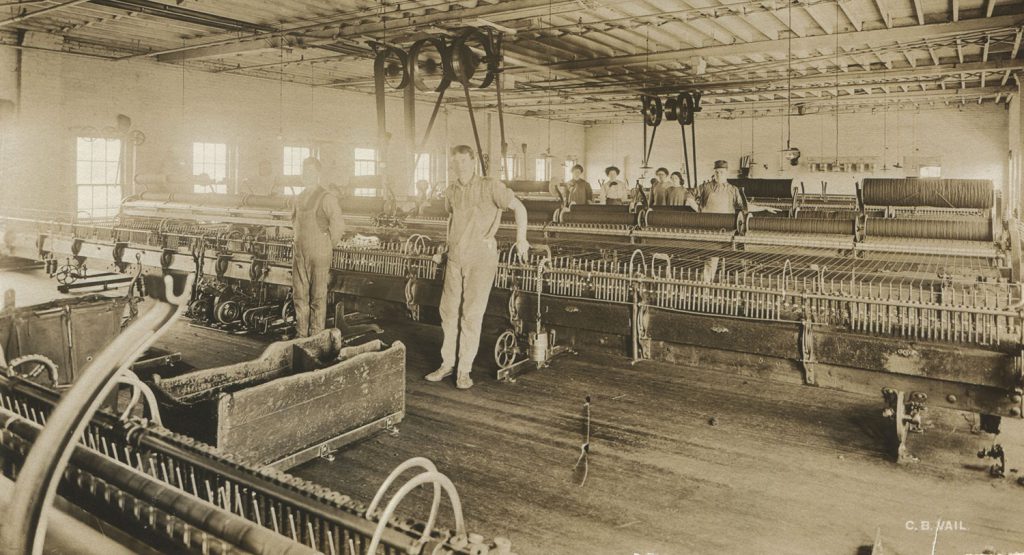
COMPANY HISTORY
Joseph Capps, born in 1811 in Kentucky, married Sarah Higgins Reid. In 1837, the couple and their infant son, Stephen, moved to Waverly where Joseph entered into a woolen mill partnership. Two years later the Cappses moved to Jacksonville, and Joseph began his own wool-carding business.
“A wool-carding plant was a tremendously important factor in the lives of early settlers as it made possible the elimination of tedious and time-consuming carding of wool with hand cards,” commented great-grandson of Joseph Capps, Robert M. Capps, in an interview with the St. Louis Post-Dispatch in 1964.
Wool-carding is a process whereby wool, cotton, flax and hair are gathered lengthwise into rolls or strands. The rolls of wool are then spun on a spinning wheel and made into yarn used to knit socks, mittens, caps, stockings and cloth for garments.
Farmers brought their fleeces of wool, which had been tub scoured at home, to the plant to be carded. Payment for the carding process was made either by leaving some of the carded wool or by exchanging most anything of value which they had on hand – bacon, eggs, butter, poultry, cord wood, etc. On such a day the entire family came along and camped on the grounds of the mill until the carding was finished which sometimes was two or three days. Sarah Capps provided hot coffee during their stay.
A year or so after opening, spinning equipment was added for spinning the wool into yarn. Farmers soon started selling their raw wool and purchasing finished yarn. The carding and spinning continued to flourish, and in 1852, looms and weaving machinery were added, and the manufacture of the first rough, unfinished cloth began. Wool blankets accounted for a large part of the production, although flannels, skirtings and women’s dress goods were also made.
Joseph and Sarah Capps’ eldest son, Stephen R., joined the partnership in 1857, and their second son, William E., in 1862, when the name Jacksonville Woolen Mills was established. On March 10, 1872, Joseph Capps passed away after a brief illness.
In 1878, the Cappses’ third son, Joseph L., joined the business. By that time, the mill was producing 3000 yards of cloth a day and employed about 75 workers. Joseph and Sarah’s fourth son, Charles, later worked at the company but never became a partner as his three elder brothers did.
The manufacture of men’s trousers at the mill began in 1885. Employment rose to over one hundred, and annual sales exceeded $200,000. The company incorporated in 1886 under the new name of J. Capps & Sons, Ltd.
A colorful part of J. Capps & Sons’ history quite literally was the production of Indian trade blankets. Indian trade blankets are commercially woven wool blankets with striking geometric patterns. Trade blankets have long been an integral part of Native American culture. They’re used for clothing, bedding, warmth, ceremonial dances and gifts for important occasions.
Capps continued to produce the blankets until 1917 when the mill shifted to war production.
By the early 1900s, most of the Capps production line was devoted to making men’s suits and overcoats.
The wholesaling of cloth was discontinued in 1904, and all cloth Capps made was used in clothing production. The mill was closed in 1927 and by 1930, all fabric for clothing production was purchased from suppliers, and the manufacture of cloth was discontinued.
1939 was a banner year for the company as it celebrated its centennial. J. Capps & Sons, Ltd. produced and distributed over 50,000 suits that year, and the company grossed over a million dollars.
To recognize the company’s anniversary, a series of events was held over four days in September. Climaxing the festivities was the dedication of a large granite historical marker at the site of the first plant. The marker was a gift to the company from the employees of the J. Capps & Sons and the Amalgamated Clothing Workers. The centennial celebration culminated with a Centennial Dinner at MacMurray College’s McClelland Hall attended by over 500 people.
During World War II, Capps manufactured the Navy pea jacket. The company had contributed to three previous war efforts. Blankets were produced for the troops during the Civil War. Uniforms were made for the Army during the Spanish-American War and again in World War I. One of the company’s most cherished possessions was a “Certificate of Achievement” for excellence in production which the Navy presented to it for the pea jackets.
In 1943, Capps purchased the assets of Prosterman-Spiesberger Clothing Factory which was located at the corner of West Douglas and North West Streets. During WW II clothing for the retail market was shifted to this location since all production capacity at the Capps factory was devoted to manufacturing the Navy pea jacket.
When Capps’ 125th anniversary rolled around in 1964, J. Capps & Sons, Ltd. was the oldest manufacturer in Morgan County, and in its line of business, the oldest manufacturer in the U.S. About 450 union workers were employed, and Capps clothing was sold in more than 800 retail stores in 40 states. To produce a men’s coat, there were 145 separate operations, and to make a pair of men’s pants, 60. The plant produced one item of clothing every minute of the working day. Even though the plant operated with the most modern equipment, highly skilled workers were needed to perform many operations which could only be done by hand to produce the quality of suit known throughout the trade as a “Capps product.”
Unfortunately, just a decade later the company ended up in bankruptcy. While the root of its financial difficulties is not known, some speculate the rise of the popularity of polyester fabric may have contributed to the company’s demise. Capps’ production was designed for the beautiful, fine woolen fabrics that graced its doors for so many generations. Maintaining its quality with polyester was a challenge.
In an attempt to open a new, profitable market, in the mid-1970s Capps engineered personal protection garments, a.k.a. bullet-proof clothing, made with Kevlar. The designs were well-received, and a significant amount of publicity around the products was created. But the company was unable to arrange the financing of or a financial partnership for the production of the garments.
J. Capps & Sons, Ltd. went out of business in August of 1975, closing its doors after 136 years.
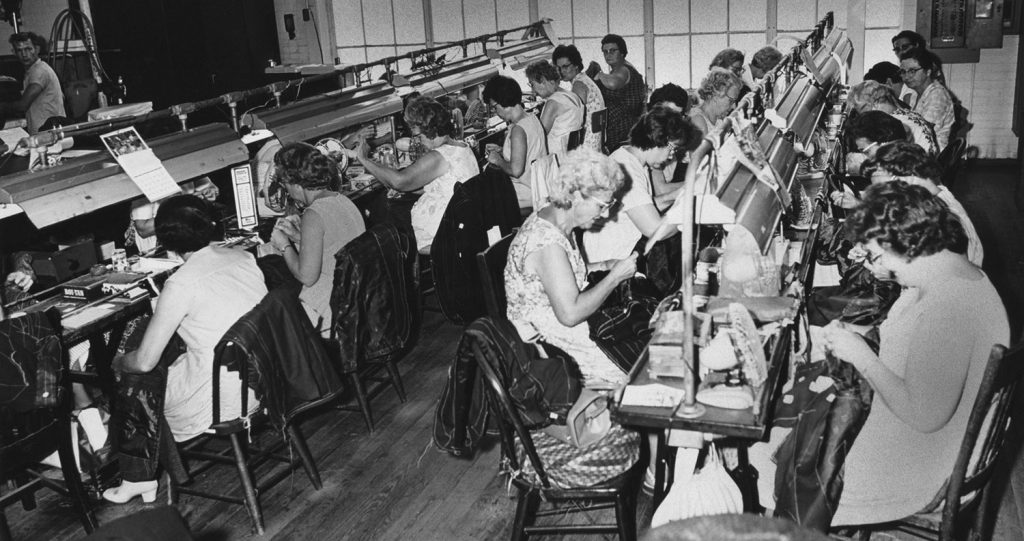
THE THREADS OF TIME
1837
Joseph Capps, his wife, Sarah, and infant son, Stephen R., move from Kentucky to Waverly, IL to become a partner in a wool-carding business
1839
Joseph Capps starts his own wool-carding business in Jacksonville
1841
Joseph Capps purchases land on the east side of Church between Douglas and Lafayette for a plant and a home
1852
Looms and weaving machinery are added to the plant
1857
Joseph Capps’ eldest son, Stephen R., joins the partnership. The plant is making blankets, flannels, skirting, and women’s dress goods.
1862
Joseph Capps’ second son, William E., joins the business and the name Jacksonville Woolen Mills is adopted.
1867
The site of the current building complex is acquired.
1872
On March 10, Joseph Capps dies after a brief illness.
1878
Joseph Capps’ third son, Joseph L., joins the business. In that year the industry was making 3000 yards of cloth daily and employed approx. 75 people.
1885
Capps begins to manufacture men’s trousers.
1886
The business is incorporated as J. Capps & Sons, Ltd.
1890
A tailoring plant is established to produce suits, trousers, and overcoats.
1904
The wholesaling of cloth is discontinued, and all cloth is used to make clothing.
1927
Due to heavy losses for several years the woolen mill is closed and the company focuses solely on the clothing division.
1939
The company celebrates its centennial. That year Capps’ approximately 400 employees produced and distributed 50,000 suits a year, and the company grossed over a million dollars.
1943
Capps purchases the assets of Prosterman-Speisberger clothing factory located at the corner of West Douglas and North West Streets.
1964
Capps celebrates its 125th anniversary. At the time it was the oldest manufacturer in Morgan County, and in its line of business, the oldest manufacturer in the U.S.
1975
Capps engineers and markets personal protection garments, a.k.a. bullet-proof clothing, made with Kevlar but is unsuccessful in gaining the financial backing needed to produce the garments, and the business closes in August 1975.
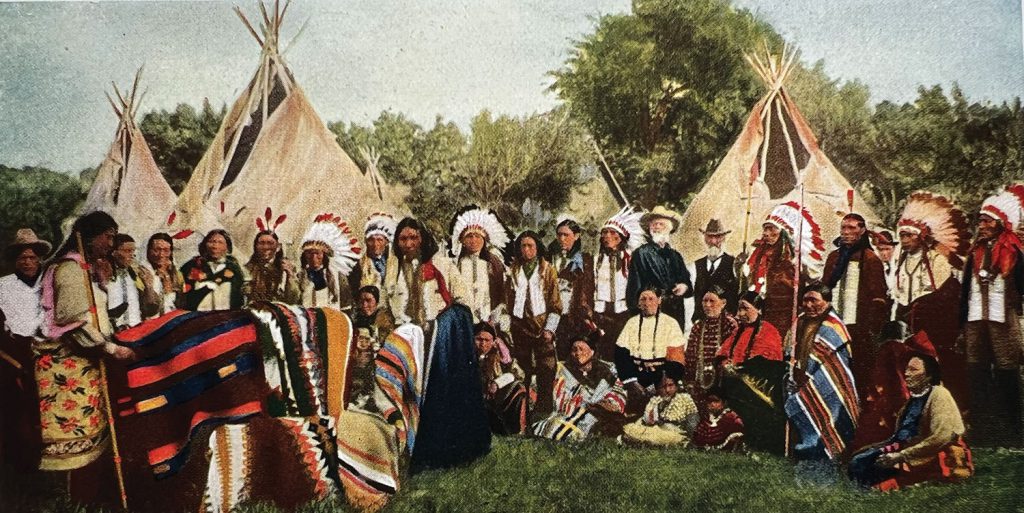
WARM THREADS
Besides cloth, in the late 1800s a big business for J. Capps & Sons was the production of Indian trade blankets. Even the legendary Buffalo Bill endorsed the blankets. Like Buffalo Bill, Capps capitalized on early 20th-century Americans’ fascination with the Old West and Native Americans.
Indian trade blankets are commercially woven wool blankets with striking geometric patterns. Trade blankets have long been an integral part of Native American culture. They’re used for clothing, bedding, warmth, ceremonial dances and gifts for important occasions.
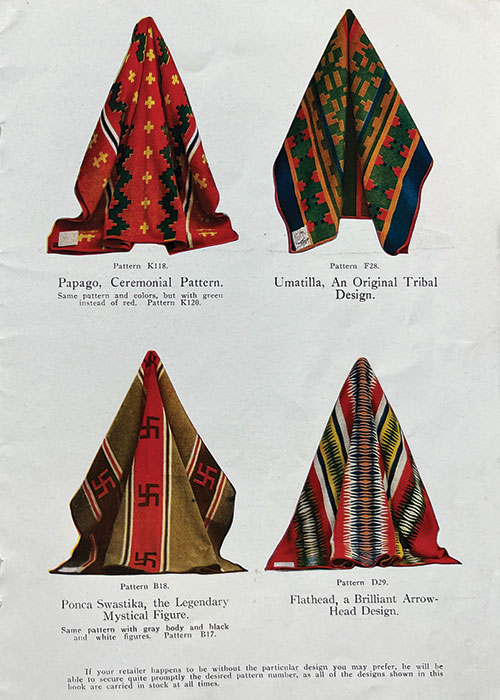
The first recorded sale of a geometric-pattern Indian blanket was by J. Capps & Sons in 1892. Capps sold the blankets to federal Indian agents, as they were called at the time, who distributed them. The Indians not only used the blankets themselves but built up a profitable trade on their reservations by reselling them. “Tourists often bought them as ‘genuine’ only to find the Capps label in the corner,” wrote Robert M. Capps, president of the factory from 1946 until his death in 1968.
By 1910, Capps had begun advertising the blankets nationally. The company extolled the benefits of its product with glowing ads like the following from 1910: “There is nothing so beautiful – so warm – so cheery – as a genuine Indian Blanket or two. Women prize them more than any other single decoration in their homes. They are a mark of luxury – of refinement – of taste.”
Col. William F., a.k.a. “Buffalo Bill,” Cody, who visited Jacksonville at least five times, purchased blankets from J. Capps & Sons for his Wild West shows and endorsed Capps products. In a 1911 letter to the business, he wrote: “I am very pleased to say, that for characteristic Indian designs, beauty and brilliancy of color, and for quality, the ‘CAPPS INDIAN BLANKET’ is superior to any blanket that I am acquainted with, made for the Indian trade.”
The Capps Indian blankets came in 22 distinct designs and in more than 200 different color combinations, according to Robert W. Kapoun and Charles J. Lohrmann, authors of “Language of the Robe: American Indian Trade Blankets.” The blankets were made of 100 percent pure fleece wool, and in 1911 sold for $7.50.
“Each Capps design was distinguished by the name of a Native American tribe — not that the patterns really had much to do with the tribes for which they were named,” wrote Mr. Kapoun and Mr. Lohrmann. “Tribal designs were used (probably with improvements by our Portuguese weavers),” Mr. Capps wrote. Vintage collectors love the Capps blankets for their simple yet elegant patterns and beautiful coloration.
“Collectors throughout the country have been collecting the blankets for years,” said Ted Rammelkamp Sr., of Jacksonville when interviewed by the Jacksonville Journal-Courier in 1999. A Capps descendant and former member of the factory’s board of directors, Rammelkamp continued, “The Capps blankets are part of the lore of the West.”
UNRAVELING A THREAD
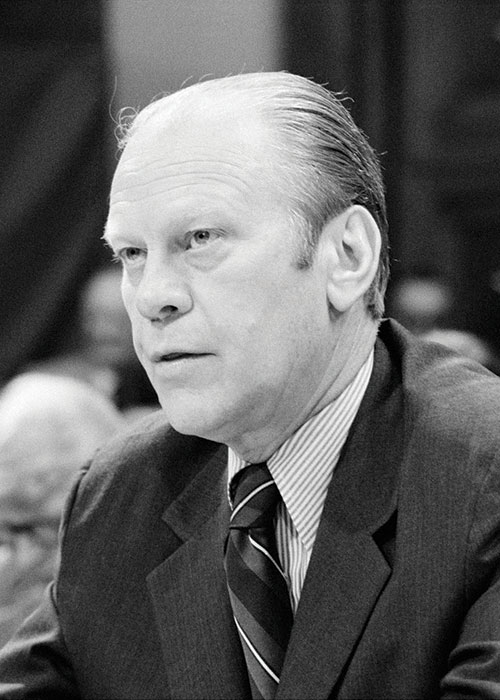
Might a piece of clothing made at J. Capps and Sons, Ltd. have protected President Gerald Ford?
In the September 21, 1975, edition of the Chicago Tribune, an article by John Elmer headlined Ford puts bullet-proof vest right in style appeared. Interviewed for the article was William T. Capps, the last president of J. Capps & Sons, Ltd. Below are excerpts from the article.
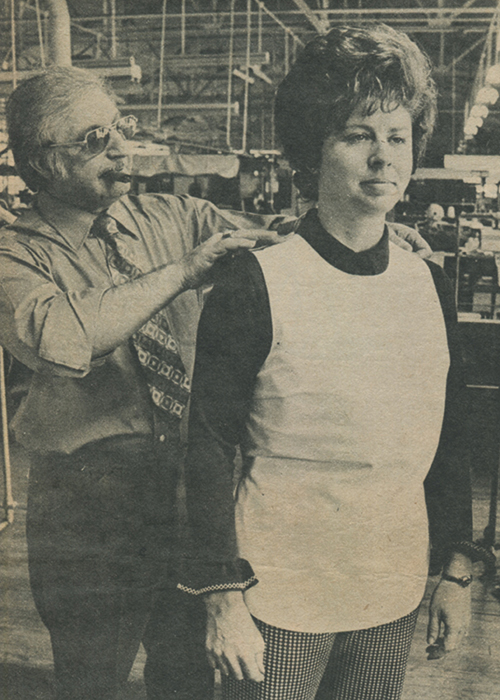
“William T. Capps is pretty sure his Downstate Illinois firm made that bullet-proof vest which President Ford has been sporting, but the publicity won’t do him much good. His firm went out of business last month.”
“J. Capps was a pioneer in making ‘armored fashions’ out of the Du Pont fabric developed as a tire cord. The fabric, Capps says, is half as heavy as nylon but five times as strong as steel.”
“The Capps firm sent a large number of vests to Washington several months ago for trial use by the Treasury and State Departments, and the President’s vest looks like one of those, Capps says.”“Capps said his firm, founded in 1839 as a men’s wear manufacturer, was the first to make Kevlar-filled fashions when it got into the protective clothing field last year.”
So being the intrepid researchers we are at the Jacksonville Area Museum, we contacted the Gerald R. Ford Presidential Library & Museum to see if it had the clothing President Ford wore on September 5, 1975, the day Squeaky Fromme attempted to assassinate President Ford. The museum does have a bullet proof vest in its collection and a curator was kind enough to check it for any tags. She found none. So, while William Capps’ belief can’t be verified, the possibility still exists that a vest made at J. Capps & Sons, Ltd. in Jacksonville, Illinois, may have been worn by President Ford the day Squeaky Fromme attempted to shoot him.
FAMILY THREADS
Joseph and Sarah Capps were strong believers in education and community service. They instilled those values in their children, who instilled them in their children, and so on and so on. Generation after generation the Cappses’ descendants have distinguished themselves and contributed to their communities, the nation and the world.
Joseph and Sarah Capps
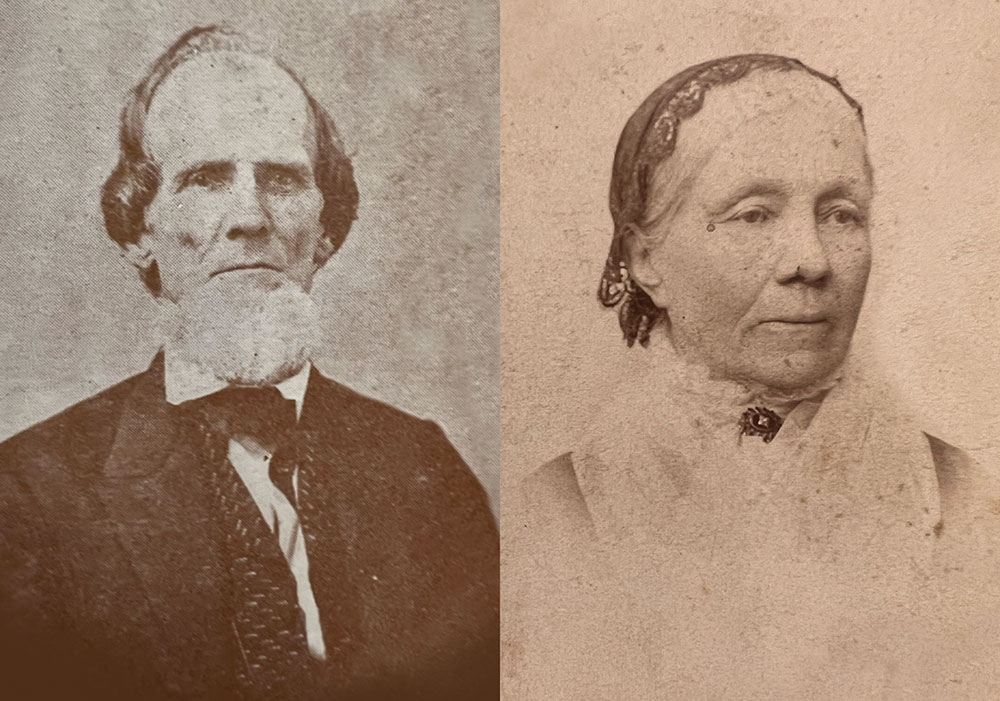
Joseph Capps was born January 23, 1811, in Kentucky. When he was about sixteen, he left home and went to Louisville, Kentucky, where he learned the machinist’s trade and gained experience in handling and carding wool. He married Sarah A. Higgins Reid and in 1837 their first child, Stephen, was born in Kentucky.
Joseph’s father, Caleb Capps, was a slave-holding planter. Joseph came to abhor slavery and was determined to move to a state where slavery was illegal, so in 1837, he and his family relocated to Waverly, Illinois, for Joseph to become a partner in a wool-carding business. During the winter of 1838-39, he built an engine and wool-carding machine after which he severed his Waverly partnership, and the family moved to Jacksonville. Joseph opened his own wool-carding business and the company that would later become J. Capps & Sons, Ltd. was born.
When Joseph opened his business, the country was in the depth of the depression which followed the Panic of 1837. Only the courageous opened businesses in that trying period of the nation’s history. With meager resources, Joseph relied wholly upon his ability.
For the next three and a half decades, Joseph, along with his sons, took the company from a wool-carding business to a manufacturer of cloth and a maker of blankets, flannels and women’s dress goods under the name of Jacksonville Woolen Mills.
Joseph and Sarah had seven children, Stephen R., Emma J., William E., Martha W., Joseph E., Charles C., and Euphemia E. They were early patrons of education. Joseph had not enjoyed collegiate training, and they were determined that their children should have the opportunity to secure higher education. Strong Methodists, they contributed generously to the Illinois Female College, which became MacMurray College. Joseph died after a brief illness at the age of 61 on March 10, 1872. Sarah
passed away on January 24, 1892, at the age of 72. She and Joseph are buried in Diamond Grove
Cemetery.
Dr. Edward Capps
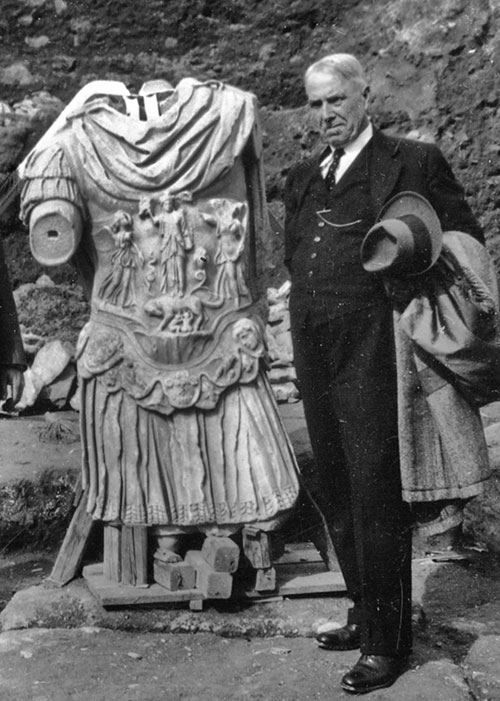
Dr. Edward Capps, the third son of Stephen Reid Capps and Rhoda Tomlin Capps and grandson of Joseph and Sarah Capps, was born in Jacksonville on December 21, 1866.
Edward Capps graduated from Illinois College in 1887 and received a doctorate from Yale University in 1891. He studied abroad including at the American School of Classical Studies in Athens. He taught at the University of Chicago and at Harvard and Johns Hopkins universities.
Dr. Capps began teaching at Princeton in 1907, a position he would hold until his retirement in 1936. As a scholar he was noted for his productivity and received praise for his work on classical philology. He also had a notable friendship with the Princeton president, Woodrow Wilson, who became the 28th President of the United States.
By the time Woodrow Wilson was elected president, Dr. Capps had become one of the foremost authorities in the United States on Greek affairs. As such, he was President Wilson’s choice to head the American Red Cross mission to Greece during World War I. While there, Dr. Capps was appointed the U.S. envoy extraordinary and ambassador plenipotentiary to Greece and Montenegro.
Dr. Capps would also make a name for himself serving on the managing committee of the American School of Classical Studies at Athens (ASCSA) from 1908 to 1950, during which he acted as chair between 1919 and 1939. As a postgraduate student in Athens, Dr. Capps had performed archaeological work in Greece, so in the late 1920s he obtained permission for the American School of Classical Studies to conduct archaeological excavation of the Agora. The ancient Agora was the center of Athens. It was a market, a meeting place, and the social, political, and commercial hub of the ancient city.
The excavation was delayed for many years because the Agora site was in the heart of modern Athens, and the expense of clearing the area was beyond the power of the Greek government. But Dr. Capps steered the project through legal dealings to acquire the land, remove 350 small houses and find the Agora. He managed the project in spite of World War II and two invasions of Greece. Today, the Agora is one of the most important sites of the Greek capital of Athens. In honor of his contributions to the school, the ASCSA built the Edward Capps Belvedere overlooking the Athenian Agora from the Agoraios Kolonos and launched the Edward Capps Society to honor individuals who provide for the future of the school. Dr. Capps, at the time of his death in 1950, was lauded by The New York Times as “the best-loved foreigner in Greece.”
Dr. Stephen Reid Capps II
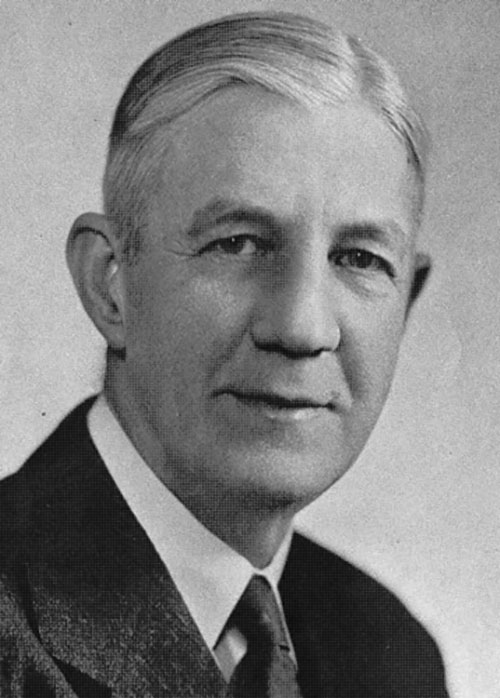
Dr. Stephen Reid Capps II, the eighth child of Stephen and Rhoda Capps and the grandson of Joseph and Sarah Capps, was born in Jacksonville on October 15, 1881. Like his four brothers, Stephen studied at Illinois College. After three years he transferred to the University of Chicago where he came under the strong influence of the Geology Department, receiving his bachelor’s degree in Geology in 1903.
While at the University of Chicago he taught at the University High School, took graduate courses, and did field work in Wyoming, Colorado and Ontario. Steve, as he liked to be called, earned a PhD there in 1907.
In 1908, Steve accepted an invitation from Alfred H. Brooks, who was the chief geologist for Alaska for the United States Geological Survey (USGS) from 1903 to 1924. For the next 30 years, he devoted his talents to furthering the work of the Alaska unit of the Survey. He headed the work over the vast tract of territory west of the Copper River region and south of the interior plateau country including the tens of thousands of square miles west of Prince William Sound and adjacent to the Sistine River and the central and western part of the Alaska Range. Much of the scientific information had to be gleaned on the run. The team was often in the midst of chopping trail or extricating the pack train from treacherous ground or engulfing quicksands, or scaling slopes and fording swift glacial streams.
Steve’s scientific contributions were more diverse than geologic mapping and mineral resource surveys. He was one of the first to describe and map multiple episodes of Pleistocene glaciation in Alaska’s mountain ranges. And he was always interested in flora and fauna of the regions where he worked as a geologist.
During the World War I years, Steve joined a team whose mission was to determine where minerals needed for war industries occurred in their natural state. The team worked in the states but also had international sources and prepared a classified report that described the worldwide distribution of what we now call ‘Strategic and Critical Minerals’. This information was used during post-war actions, including deliberations for the Treaty of Versailles.
For a time, Steve worked in the private sector but returned to the USGS. When Alfred Brooks died, USGS asked him to serve as Acting Chief Alaskan Geologist until a replacement could be found for Brooks. Steve did so for a short time but wished to return to field research and did so. He was not comfortable being an administrator.
In 1937, the Geological Branch of USGS transferred Steve from the Branch of Alaskan Geology to work in the western states. His first assignment was the study of gold placers in Idaho. In 1940, with war near, the USGS again asked him to work on strategic and critical minerals. After serving as Assistant Chief Geologist of the USGS under the condition that he would be re-assigned, he worked on several projects until his untimely death in 1949.
Besides receiving honors from organizations throughout his career from the National Geographic Society and from the College Division of the University of Chicago, Steve has been honored by the naming of a 10,790-foot Mount Capps in Denali National Park; by Capps Creek, a tributary of the Chichantna River south of Beluga Lake; and by Capps Glacier in Tordrillo Mountains, 26 miles northwest of Tyonek.
Rhoda Jeanette Capps Rammelkamp
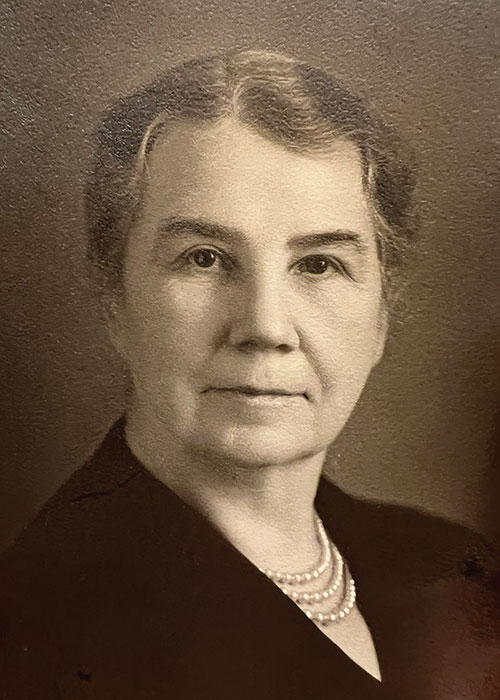
Rhoda Jeanette Capps Rammelkamp, born January 21, 1878, was the sixth child of Stephen and Rhoda Capps and a granddaughter of Joseph and Sarah Capps. She and her sister Louise, who taught at Illinois School for the Deaf for many years, and two of her brothers, Alfred and Harry, were the only children who as adults made Jacksonville their home. Both Alfred and then Harry succeeded their father at J. Capps & Sons, Ltd.
Rhoda grew up in a strict but loving home. Her parents believed higher education was the doorway to successful and satisfying careers. Both her parents served as trustees of the Illinois Female College, which later became MacMurray College. In the hallway of their home was a library with stacks of books — Dickens, Hawthorne, Fenimore Cooper, Gibbon’s Decline and Fall of the Roman Empire and Grote’s History of Greece.
Rhoda’s brother Joseph recalls this about her: “Jen graduated University of Chicago; her best friend was Ruth Vanderlip. On a visit to Washington with Ruth, she was rushed by handsome Frank Vanderlip, Assistant Secretary of the Treasury — opera — flowers — attention ad lib-proposal. Jen declined — thought he was not really in love. Later she fell for homely Charles Rammelkamp, professor of History and Political Science, later to be chosen president of Illinois College.”
Before she married, Rhoda supervised an elementary physical education class for women on the Illinois College (IC) campus. She did marry Professor Charles Rammelkamp and spent her married life serving the College along with her husband. There are many letters from students who remembered and loved her. She was instrumental in helping the women of IC obtain the David Smith House.
After the death of her husband, Rhoda served as IC Alumni Secretary for many years. Shortly before her death she saw the chapel at the College dedicated to her husband. Rhoda and Charles had five children, all of whom were students at IC. Rhoda died in 1962 and is buried in Diamond Grove Cemetery.
Robert Miner Capps
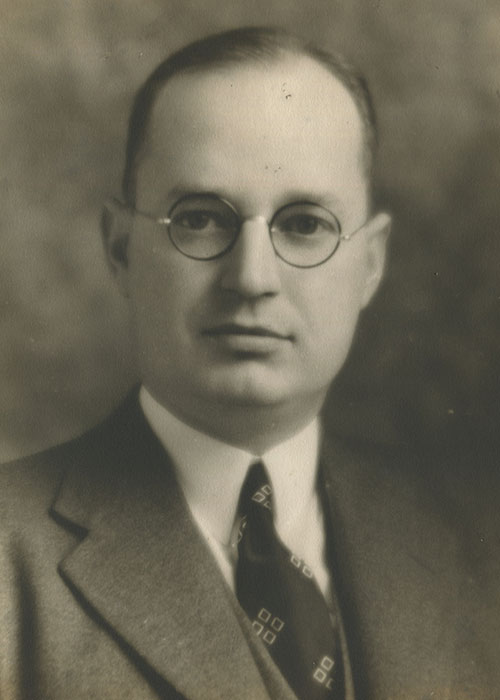
Robert Miner Capps led J. Capps & Sons, Ltd. as its president from 1946 until his death in 1968. Born November 16, 1894 to Alfred and Anna Capps, Robert was a great-grandson of Joseph and Sarah Capps.
Joining J. Capps & Sons in 1919, Robert learned the clothing business as a traveling salesman and then as secretary-treasurer starting in 1931. In 1946, he became president of J. Capps & Sons, and for 22 years led the company through a period of modernization and expansion. In its Memorial Resolution, the Board of Trustees eulogized “his personal qualities of integrity, compassion and friendliness [that] have become part of the image of J. Capps & Sons, Ltd.” Bob’s experience and advice were valued by his peers in the industry, who elected him a director of the United States Clothing Manufacturers Association in 1950.
Active in civic affairs, with a “deep sense of family responsibility to the Company, the Community and to the cause of human advancement,” Robert served for 22 years on the Board of Trustees of his Alma Mater, Illinois College, and was a Trustee of Passavant Memorial Area Hospital. He was awarded a Citation for Distinguished Citizenship in 1958 from Illinois College “for his forty years of constructive activity in the affairs of his community.”
His family remembers Robert as a scholar and historian at heart. In 1966, he started a project to record the history of J. Capps & Sons. His unfinished manuscript is rich in detail, including such childhood memories as the steam engine that powered the mill, and the strike of 1902 when he was just 7. Full of anecdotes about unionization, day-to-day business, men’s fashion, and company employees, the “Dear Sam letter,” so named by his daughter Frances, chronicles the ups and downs of an American business during the first half of the 20th Century. Although unfinished, Frances recognized its historical value and deposited a copy with the Smithsonian Institution.
The following account of the production of Indian blankets by J. Capps & Sons, Ltd. is taken from the writings of Robert M. Capps.
“Around the turn of the century an unusual type of business developed for the woolen mill — commercial blankets for the ‘blanket-wearing’ Indians on the western reservations. Tribal designs were used (probably with “improvements” by our Portuguese weavers). Many tribes were represented: Navajo, Crow, Pueblo, Apache, Zuni, Comanche, Arapaho, Hualpai, Cheyenne, Shoshone, Kiowa, Sioux, Flathead, Osage, Moqui, Klamath, and others. These were beautiful blankets in bright colors and design. Tourists often bought them as “genuine” only to find the Capps label in the corner.”
“Buffalo Bill used to ‘make Jacksonville’ with Pawnee Bill and Annie Oakley, the Dead Wood Stage, etc., plus assorted Indians and western types — all very thrilling to young boys like me. They set up their teepees on the old fairground lot on Lafayette. Every kid in town somehow managed to be there for the show. Mr. Cody would bring the Indians to our plant, where they selected blankets. We have testimonials from both Cody and Lillie as to the quality and authenticity of design.”
“Perhaps the peak of this undertaking was about 1913 when an advertising campaign was presented to the general public — full color ads in national magazines such as The Saturday Evening Post. I am sure that Mr. Harry M. Capps was responsible for this promotion. The blankets were stocked and featured by many fine stores, including Abercrombie and Fitch in New York and V.L.&A. in Chicago. At this time the blankets were used in coats for both men and women, the men’s coats being made in a Norfolk model.”
Charles M. “Chili” Capps
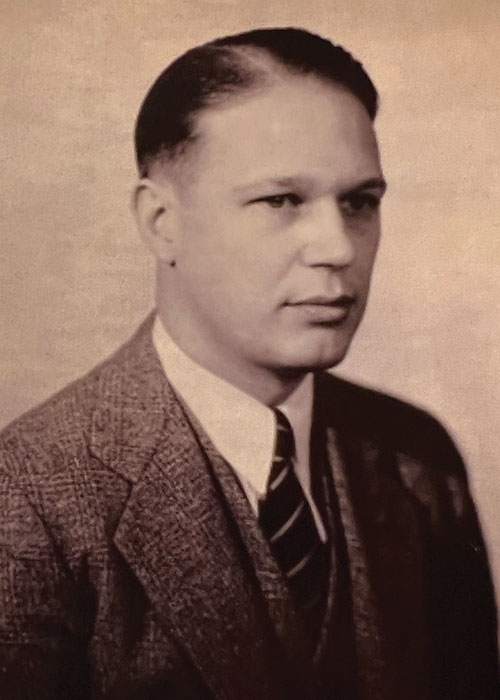
Charles M. Capps, known to his friends as “Chili,” was born in Jacksonville on September 14, 1898. The great-grandson of Joseph and Sarah Capps, he grew up not too far from the Jacksonville Woolen Mills and as a teenager worked at the Mills. It is said that Charles was inspired by the dyes and patterns created by weavers at the Mills which sparked his interest in art.
Chili enrolled at Illinois College and graduated as salutatorian after only three and a half years. It was at Illinois College that he began his explorations in drawing, block prints, and aquatints. He contributed to “The Rambler”, the student newspaper, and “Rig Veda”, the school yearbook, as a draftsman and cartoonist.
After graduating from Illinois College, Chili attended the Chicago Academy of Fine Arts and the Pennsylvania Academy of Fine Arts where he studied the fundamentals of drawing, painting, illustration, creative advertising, commercial art, fashion, and theater. He then returned to Illinois and worked with the advertising agency Hahn-Rodenburg Company in Springfield, Illinois. He continued to study art by taking drawing and painting classes at the Illinois Woman’s College (now MacMurray College) taught by impressionist landscape painter Nellie Knopf.
Chili married Anna Palmer in 1923, and after several moves around the country they settled in Wichita, Kansas. Chili accepted a position with Western Lithograph. He soon began experimenting with woodcuts, creating a series of award-winning bookplates, and from 1931, did etchings. The quality of his prints earned him membership in professional printmakers’ organizations including the Chicago Society of Etchers, where the committee upon seeing his work, burst into applause.
A printmaker especially known for subtle tonal variations in aquatints, Chili did many images of Midwestern scenes and Southwestern subjects as well as commercial art endeavors. He was especially taken with the adobe architecture of Taos and Santa Fe. He created his own plates, and turning out editions of about 100, signed and numbered each one in pencil. In total, he completed about 80 prints, of which half are aquatints, a third etchings and drypoints and the others blockprints and lithographs.
Noted for his dry sense of humor, he had a sign over his studio door: “Phooey to the Louvre”. One of his friends said that Chili “could puncture a balloon of self-important pomposity.”
An active member of the Prairie Print Makers of Kansas, he served as its President for twenty-three years. He was also active in the Society of American Etchers, the Chicago Society of Etchers, Philadelphia Society of Etchers, Northwest Printmakers and Printmakers Society of California. In 2019, the Wichita Art Museum had an Exhibition of his works. Chili Capps died July 17, 1981, in Wichita, Kansas.
Dr. Charles Henry “Rammel” Rammelkamp, Jr.
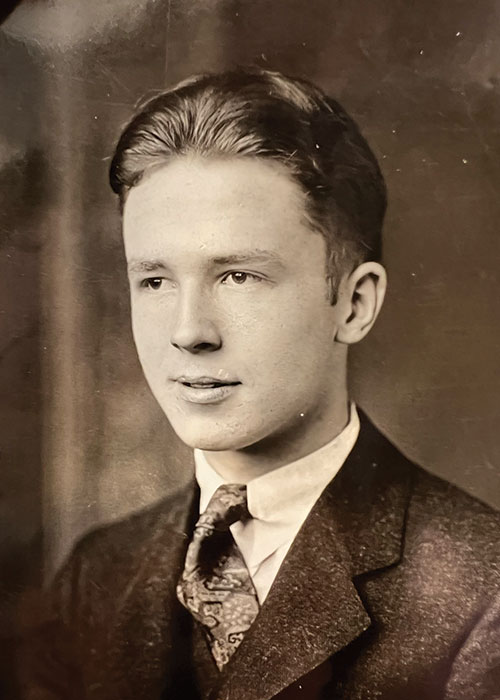
Dr. Charles Henry Rammelkamp, Jr., born May 24, 1911, was a great-grandson of Joseph and Sarah Capps. He grew up in Jacksonville and graduated from Illinois College in 1933. “Rammel,” as he was called, went on to medical school at the University of Chicago, receiving his Doctor of Medicine in 1937.
The course of his career was really determined in 1939 when he went to Thorndike Memorial Laboratory of Boston City Hospital as a resident physician. Dr. Rammelkamp accepted a position with Chester Keefer, a distinguished infectious disease investigator. This was the beginning of a lifelong fascination with streptococcus and the diseases it causes. Dr. Rammelkamp discovered that streptococcus can cause rheumatic fever and nephritic syndrome, for which he received the Lasker Award.
In addition to being a longtime professor at Case Western Reserve University School of Medicine, Dr. Rammelkamp served as Director of the Department of Medicine at Cleveland City Hospital (today MetroHealth Medical Center) in Cleveland, Ohio from 1957 to 1979. He also served as Director of the Commission on Streptococcal Disease of the Armed Forces Epidemiological Board from 1959-1967 where under his leadership he fostered an environment for research and training that led to the development of many leaders in research and academic medicine.
Dr. Rammelkamp was married to Helen Chisholm, and the couple had three children. He died in Cleveland on December 5, 1981.
Dr. Rammelkamp believed that first-rate medical care is more likely to be provided by institutions devoted not only to treating patients, but to advancing knowledge and educating new generations of medical professionals. One of his outstanding attributes was his lack of desire for power or prestige. Dr. Rammelkamp shunned medicine’s political arena, but he would logically and sometimes emotionally plead the case of public hospitals. He argued that public hospitals should be the clinical settings for originating and evaluating new equipment, drugs, therapies and patient care programs.
To honor him, MetroHealth named its research center The Rammelkamp Center of Education and Research.
Roy Moore Stelle
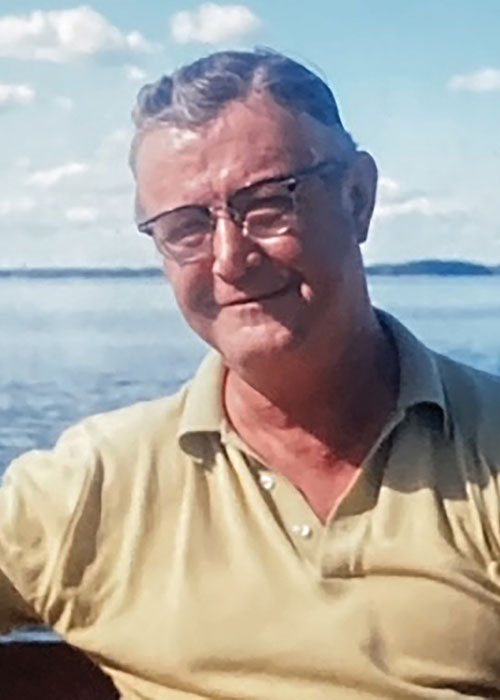
Roy Moore Stelle joined the Capps family when he married Mary Capps, a great-granddaughter of Joseph and Sarah Capps. Both Moore (as he was called in the family) and Mary attended Illinois College. Moore began a distinguished career in Deaf Education as a teacher at Illinois School for the Deaf (ISD). At one time he was Assistant Superintendent and Principal of ISD.
Known professionally as Roy, Moore went on to earn a master’s degree from the University of Massachusetts and one from the normal program at Gallaudet College. He moved to Texas in 1948 following his wartime service in the FBI where he used his lip-reading skills. He served as superintendent at the Texas School for the Deaf and Blind in Austin (1948 to 1954). From there he served as superintendent at the Colorado School for the Deaf and Blind for six years. In 1962, Moore was named superintendent at Fanwood, the New York School for the Deaf, and remained there until he retired in 1975. In 1962, he served as president of the American Instructors of the Deaf, then the largest organization of its kind.
A number of other members of the Capps family were involved in Deaf Education. Stephen Reid Capps, son of Joseph Capps, was a trustee of ISD. His daughter Louise Capps Dunlap taught at ISD for many years. Rosemary Merchant, a daughter of Stephen Capps III and great-great-granddaughter of Joseph and Sarah, taught deaf children in the primary grades in California for almost 40 years, and her cousin, Truman Stelle, son of Moore and Mary Stelle, was an English professor at Gallaudet University. Truman was active in the protests which resulted in the first deaf president at Gallaudet. Truman’s brother, Richard, has been involved in various aspects of deaf education as well. Most recently he worked at Mill Neck and Cleary School for the Deaf.
Edith Elliott Queeny

Edith Anne Elliott Queeny, the daughter of Frank Jeffris Osborne Elliott and Marilyn Anne Brannen Elliott and the great-great-great-granddaughter of Joseph and Sarah Capps, was born in 1984 in Dallas, Texas. She spent most of her childhood in Telluride, Colorado.
Edith graduated from Tufts University in 2006 and received her master’s degree in International Policy Studies and Global Health in 2012 from Stanford. She held several jobs focusing on the intersection of research, policy, and design in global health before co-founding Noora Health. She is now Co-CEO of Noora Health.
Having been a caregiver at a young age, Edith understands the universal feelings of confusion, anxiety, and distress that caregivers face and strives to infuse that level of empathy across Noora Health’s programs. She and Noora Health are committed to helping patients, families, and loved ones prepare for the demands of caregiving across health systems globally.
Just recently Noora Health received awards from the Audacious Project and the Skoll Foundation. The company has instituted programs with over 200 hospitals in India and Bangladesh. Noora Health works to give families the tools to meet the demands of caregiving. Through its work nearly two million caregivers and patients have been trained. Noora Health’s intervention has reduced cardiac surgery complications by 71 percent and newborn re-admissions by 56 percent.
Edith continues the Capps family legacy of education and community service.